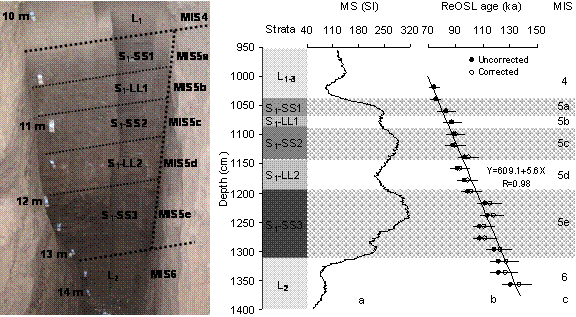Many efforts have been focused on the paleoclimate variation and environment change recorded by Chinese loess since the last interglacial period. A reliable timescale is critical for assessing the dust deposition process and paleoclimate reconstruction in the Chinese Loess Plateau as well as for correlating dust records with other paleoclimatic time-series. At present, it seems that luminescence dating has great potential to provide an effective chronology of loess deposits, especially during the last glacial-interglacial period. During the last ten years, quartz OSL dating has been widely applied to Chinese loess, mainly deposited since the last glacial. However, dating of the last interglacial paleosol (S1) in Chinese loess has remained a challenge for luminescence researchers, which may be mainly due to the (near) saturation of the quartz OSL signal at approximately 200-300 Gy and/or the pedogenesis-caused dose rate variation of S1 during the geological period.
Recently, Dr. KANG Shugang of the Institute of Earth Environment, Chinese Academy of Sciences (IEECAS) and his colleagues collected 18 closely-spaced (20 cm intervals) luminescence samples from the last interglacial paleosol at Weinan section in the southeastern Chinese Loess Plateau. By using the fine-grained (4-11 μm) quartz MAR ReOSL dating technique, also considering the correction of environmental dose rate based on the effects of pedogenesis, 18 ReOSL ages were obtained. A detailed chronology of the S1 unit was established. The main concluding remarks include, (1) the ReOSL dating technique can provide a reliable time scale for the last interglacial paleosol S1 in Chinese loess, (2) the ReOSL chronology of S1 indicates that the S1 unit corresponds to the whole MIS 5, and the ages of substrata of S1: S1-SS1, S1-LL1, S1-SS2, S1-LL2 and S1-SS3 are consistent with those of MIS 5a-e respectively, and (3) there is no obvious dust accumulation hiatus or erosion in the S1 unit and at the transition of L2/S1.
Related paper entitled “Closely-spaced recuperated OSL dating of the last interglacial paleosol in the southeastern margin of the Chinese Loess Plateau” by KANG Shugang, LU Yanchou, WANG Xulong is published in Quaternary Geochronology (2011, 6, 480-490). http://www.sciencedirect.com/science/article/pii/S1871101411000240
 © 2015 Institute of Earth Environment,CAS
© 2015 Institute of Earth Environment,CAS Address:No. 97 Yanxiang Road, Xi'an 710061, Shaanxi, China

 Location :
Location :